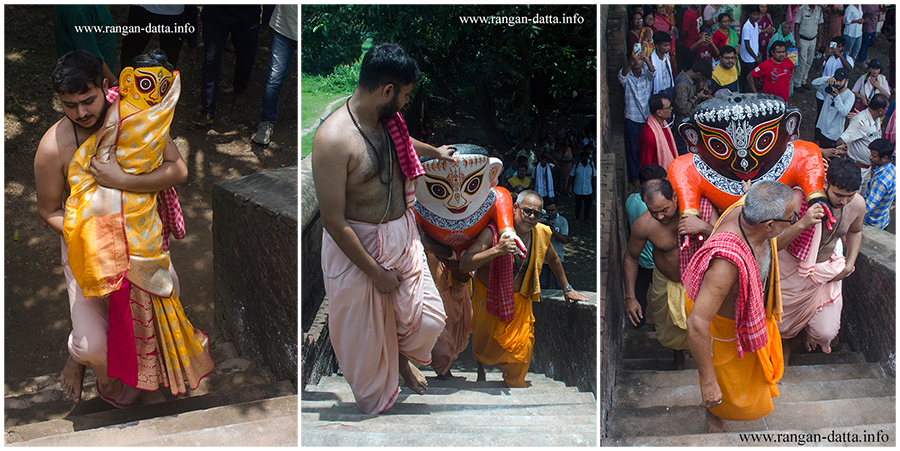Bathing ceremony of Jaganath, Balram & Subhadra
Also see: Guptipara Ratha Yatra and other rituals
Snan Yatra (or Snana Yatra) is the annual bathing festival of Jagannath, Balaram and Subhadra. It happens on the full moon day of the Bengali month of Jayeshtha (May or June). It predates the Ratha Yatra by 15 or 16 days.

Guptipara Snan Yatra Subhadra, Balaram and Jagannath being carried to the snan mancha (bathing platform)
During the festival, the idols of Jagannath, Balaram and Subhadra are taken out of the temple and are shifted to the snan mancha (bathing platform). There, they are ceremonially bathed and decorated for a public audience with the devotees.

Idols of Jagannath, Balaram and Subhadra inside the Brindabanchandra Temple
The deities are bathed with ritually purified holy water, which comes from specified sources.
After the bathing ritual, the idols are brought back to the temple. According to legend, they are said to fall ill.
This sick period lasts for 15 or 16 days and is known as Anasara. During the period, the deities are shifted to the sick room and are kept under the observation of raj vaidya (royal physician)
This is a period of isolation and darshan (viewing of the deities) are prohibited. In Puri, the idols are replaced with scroll painting of the deities, which comes from the nearby art and heritage village of Raghurajpur.
According to legend, the trio recovers under the able guidance of the raj vaidya (royal physician) and within 15 or 16 days, they are ready for their journey to their masir bari (maternal aunt’s home). The trip, which is more commonly known as Rath Yatra.
The holy bathing water is being prepared, Guptipara
Rath Yatra always reminds us of Puri and the towering chariots. Closer home in West Bengal Rath Yatra is also celebrated in a grand way, complete with towering chariots. The major Rath Yatras in West Bengal include Mahesh, Guptipara, Mahishadal, Rajbalhat and Chandannagar (Jadu Ghosh er Rath)
More on:
X
Earthen pots of bathing water, Guptipara
In West Bengal, Guptipara is known for its towering rath. It is located about 75 km from Kolkata on the Howrah – Katwa rail line is an important Vaishnava pilgrimage and houses several century-old temples. This includes the Brindaban Chandra Math, a protected monument under the Archaeological Survey of India (ASI).

Prasad being led out at Snan Mancha
The Brindabachandra Math or temple complex houses four temples:
- Chaitanya Temple
- Brindabanchandra Temple
- Ramchandra Temple
- Krishnachandra Temple
Built over a period of time they offer an interesting mix of Bengal temple architecture.
The temples are housed in a walled complex with the snan mancha (bathing platform) located on the north-eastern corner. It is an elevated platform topped with a canopy and is approached by a narrow flight of steps.
Subhadra, Balaram and Jagannath are being brought towards the snan mancha
The Guptipara Rath Yatra is complete with all rituals, including Snan Yatra. Apart from the regular rituals, the Guptipara Rath Yatra comes in with a unique ritual of Bhandar Loot held on the eve of ulto rath. On these day the bogh is not distributed but looted. (A detailed blog post on Bhandar Loot is coming soon in my blog).
Subhadra, Balaram and Jagannath are being brought up the stairs to the snan mancha
The rituals of snan yatra at Guptipara start at noon, but the devotees arrive more than an hour before. They sing kirtans, creating a festive mood. Meanwhile, the volunteers prepare the snan mancha by decorating it with flowers.

Priests prepare the idols before the Snan Yatra rituals
Another group prepares the holy ritual water by mixing milk with Ganges water and adding a dash of flowers.
The water is stored in 28 (or 29) small earthen pitchers. These are poured on the deities during the snan yatra.
One by one the idols are brought from the temple to the snan mancha. Subhadra (in Guptipara Subhdra has a yellow skin colour, but mostly it is white) is the smallest of the idols and is carried by one person.
Balaram (In Guptipara Balaram is yellow in colour, but mostly it is yellow) follows next supported by at least 3 people. Next comes the massive black idol of Jagannath carried on the shoulders of 4 or more people. Finally, the idols are laid out on the snan mancha and rituals begin.

Brindabanchandra Math complex from Snan Mancha (bathing platform)
The rituals finally end with the bathing of the three idols. The holy water is poured over the idols from the earthen pitchers. Sadly, photographers were not allowed as century old elevated snan manch is not is a stable condition to bear the weight.
More on:



